Business Research Project: Diversity and Equality at Workplace in M&S
VerifiedAdded on 2023/01/16
|38
|8205
|60
Report
AI Summary
This business research project focuses on identifying and acknowledging behaviors that support diversity and equality in the workplace, using Marks & Spencer (M&S) as a case study. The report begins with an introduction, including a research proposal outlining the research aim, objectives, and questions, alongside the rationale for selecting the topic and a work breakdown structure and Gantt chart. A comprehensive literature review explores the concepts of diversity and equality in business organizations, strategies employed by management at M&S to support diversity and equality, and the benefits of maintaining diversity and equality in the workplace. The methodology chapter details the research approach (qualitative) and methods, including sampling (probabilistic) and data collection (questionnaires) and analysis (thematic). The data collection and analysis section outlines the use of questionnaires and thematic analysis. The report concludes with conclusions, recommendations, and a personal reflective statement, discussing the research methods used, alternative methods, and areas for further research. The project aims to understand and determine behaviors that support diversity and equality within an organization, providing valuable insights for businesses like M&S. The report also includes an overview of the research, including the aims, objectives, questions, literature sources, activities, and timescales, as well as approaches and methodologies.
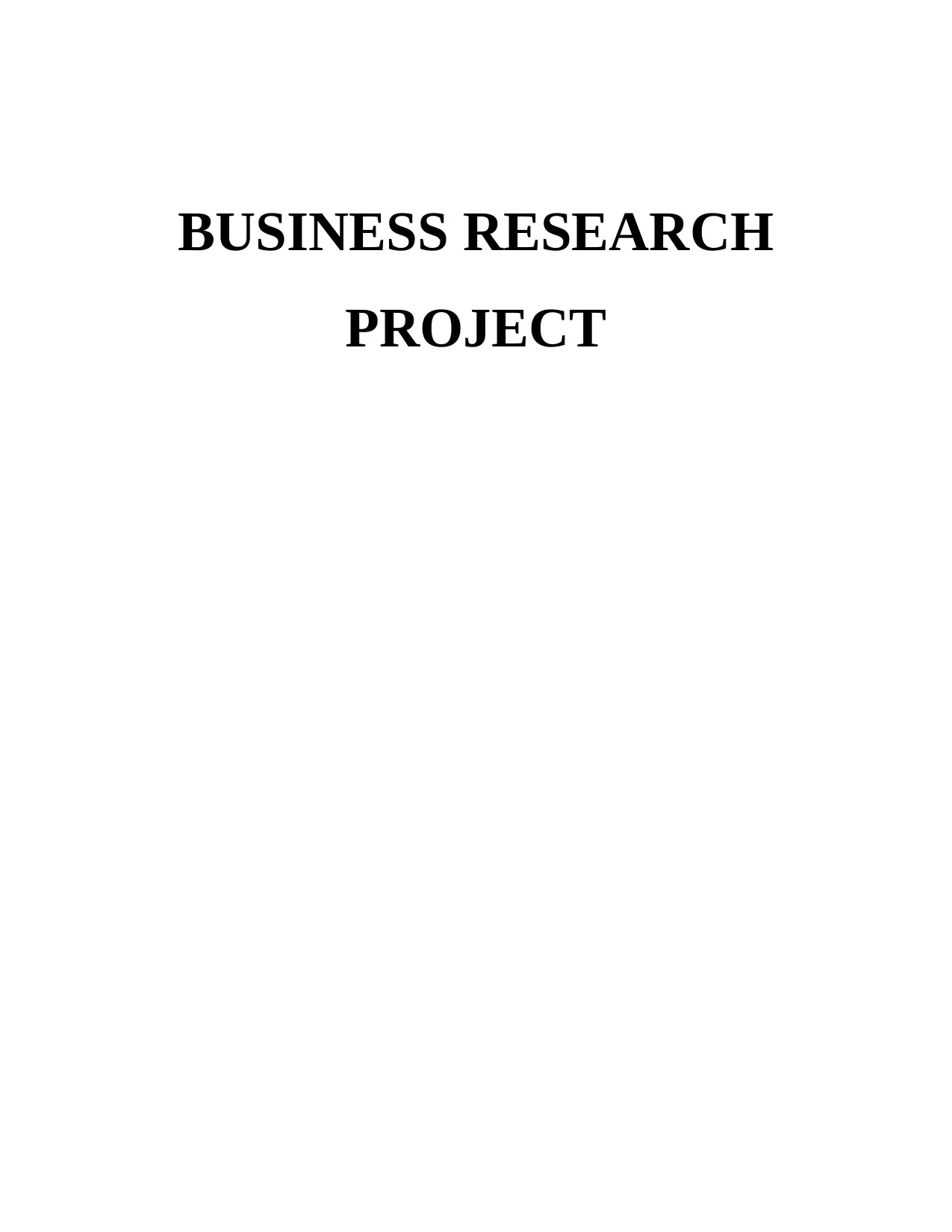
BUSINESS RESEARCH
PROJECT
PROJECT
Paraphrase This Document
Need a fresh take? Get an instant paraphrase of this document with our AI Paraphraser
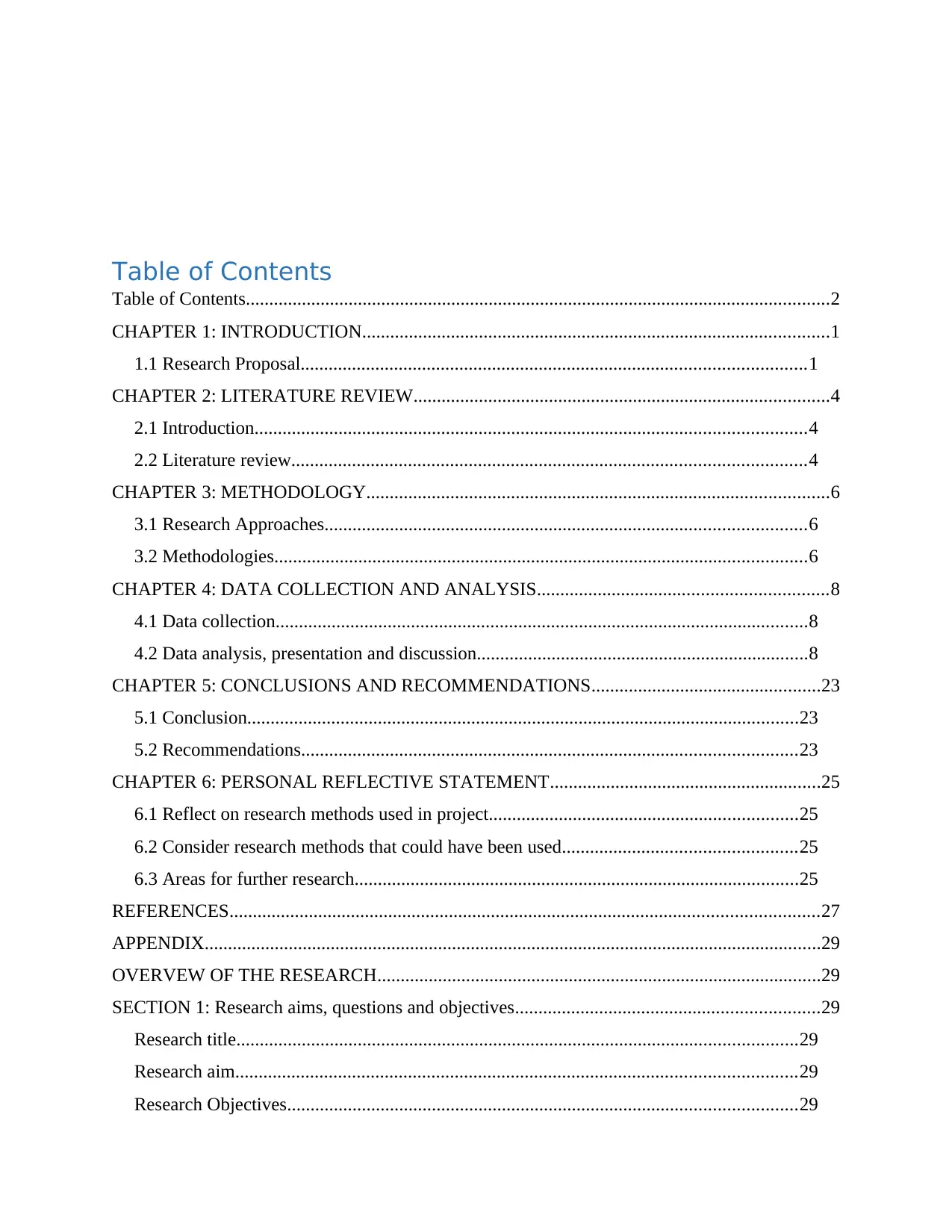
Table of Contents
Table of Contents.............................................................................................................................2
CHAPTER 1: INTRODUCTION....................................................................................................1
1.1 Research Proposal............................................................................................................1
CHAPTER 2: LITERATURE REVIEW.........................................................................................4
2.1 Introduction......................................................................................................................4
2.2 Literature review..............................................................................................................4
CHAPTER 3: METHODOLOGY...................................................................................................6
3.1 Research Approaches.......................................................................................................6
3.2 Methodologies..................................................................................................................6
CHAPTER 4: DATA COLLECTION AND ANALYSIS..............................................................8
4.1 Data collection..................................................................................................................8
4.2 Data analysis, presentation and discussion.......................................................................8
CHAPTER 5: CONCLUSIONS AND RECOMMENDATIONS.................................................23
5.1 Conclusion......................................................................................................................23
5.2 Recommendations..........................................................................................................23
CHAPTER 6: PERSONAL REFLECTIVE STATEMENT..........................................................25
6.1 Reflect on research methods used in project..................................................................25
6.2 Consider research methods that could have been used..................................................25
6.3 Areas for further research...............................................................................................25
REFERENCES..............................................................................................................................27
APPENDIX....................................................................................................................................29
OVERVEW OF THE RESEARCH...............................................................................................29
SECTION 1: Research aims, questions and objectives.................................................................29
Research title........................................................................................................................29
Research aim........................................................................................................................29
Research Objectives.............................................................................................................29
Table of Contents.............................................................................................................................2
CHAPTER 1: INTRODUCTION....................................................................................................1
1.1 Research Proposal............................................................................................................1
CHAPTER 2: LITERATURE REVIEW.........................................................................................4
2.1 Introduction......................................................................................................................4
2.2 Literature review..............................................................................................................4
CHAPTER 3: METHODOLOGY...................................................................................................6
3.1 Research Approaches.......................................................................................................6
3.2 Methodologies..................................................................................................................6
CHAPTER 4: DATA COLLECTION AND ANALYSIS..............................................................8
4.1 Data collection..................................................................................................................8
4.2 Data analysis, presentation and discussion.......................................................................8
CHAPTER 5: CONCLUSIONS AND RECOMMENDATIONS.................................................23
5.1 Conclusion......................................................................................................................23
5.2 Recommendations..........................................................................................................23
CHAPTER 6: PERSONAL REFLECTIVE STATEMENT..........................................................25
6.1 Reflect on research methods used in project..................................................................25
6.2 Consider research methods that could have been used..................................................25
6.3 Areas for further research...............................................................................................25
REFERENCES..............................................................................................................................27
APPENDIX....................................................................................................................................29
OVERVEW OF THE RESEARCH...............................................................................................29
SECTION 1: Research aims, questions and objectives.................................................................29
Research title........................................................................................................................29
Research aim........................................................................................................................29
Research Objectives.............................................................................................................29
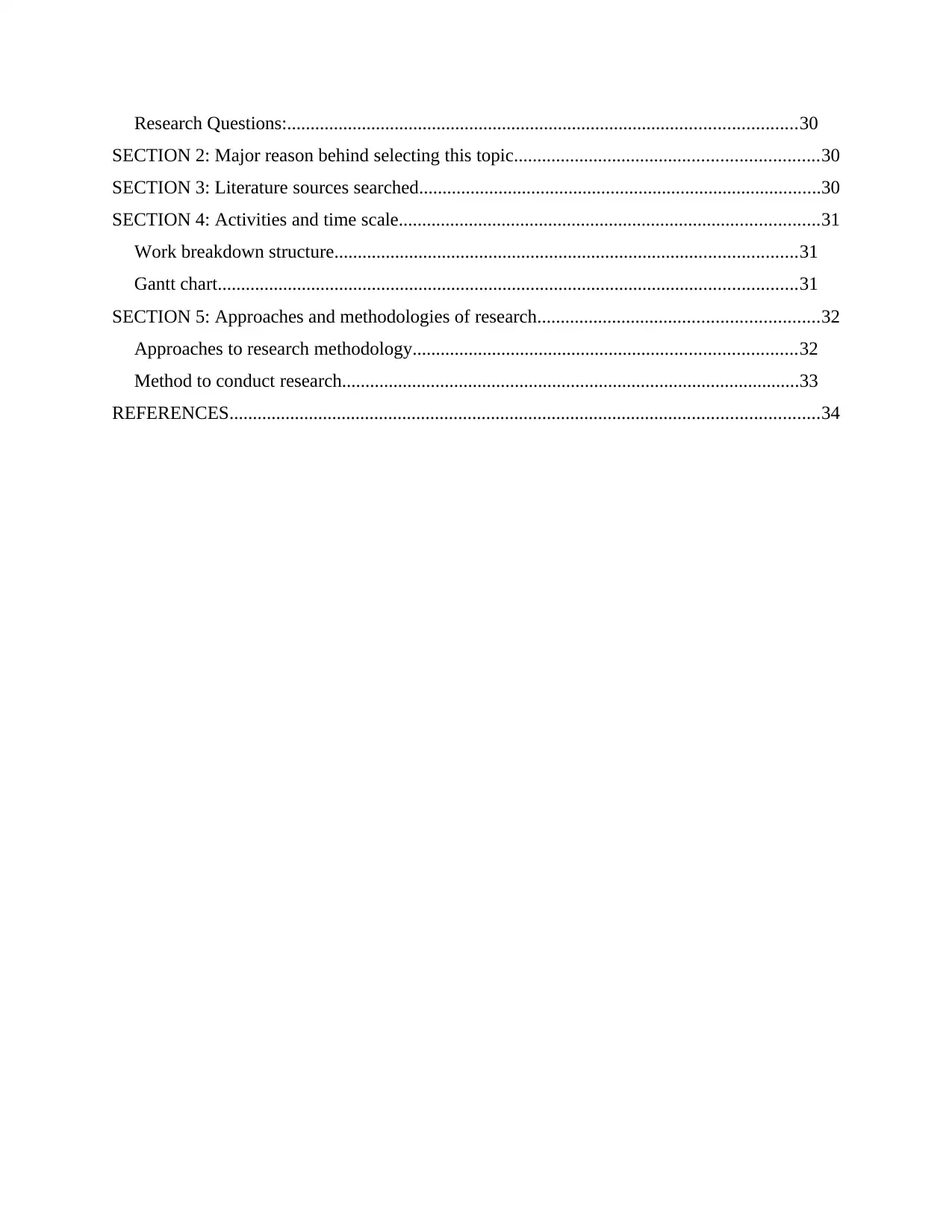
Research Questions:.............................................................................................................30
SECTION 2: Major reason behind selecting this topic.................................................................30
SECTION 3: Literature sources searched......................................................................................30
SECTION 4: Activities and time scale..........................................................................................31
Work breakdown structure...................................................................................................31
Gantt chart............................................................................................................................31
SECTION 5: Approaches and methodologies of research............................................................32
Approaches to research methodology..................................................................................32
Method to conduct research..................................................................................................33
REFERENCES..............................................................................................................................34
SECTION 2: Major reason behind selecting this topic.................................................................30
SECTION 3: Literature sources searched......................................................................................30
SECTION 4: Activities and time scale..........................................................................................31
Work breakdown structure...................................................................................................31
Gantt chart............................................................................................................................31
SECTION 5: Approaches and methodologies of research............................................................32
Approaches to research methodology..................................................................................32
Method to conduct research..................................................................................................33
REFERENCES..............................................................................................................................34
⊘ This is a preview!⊘
Do you want full access?
Subscribe today to unlock all pages.

Trusted by 1+ million students worldwide
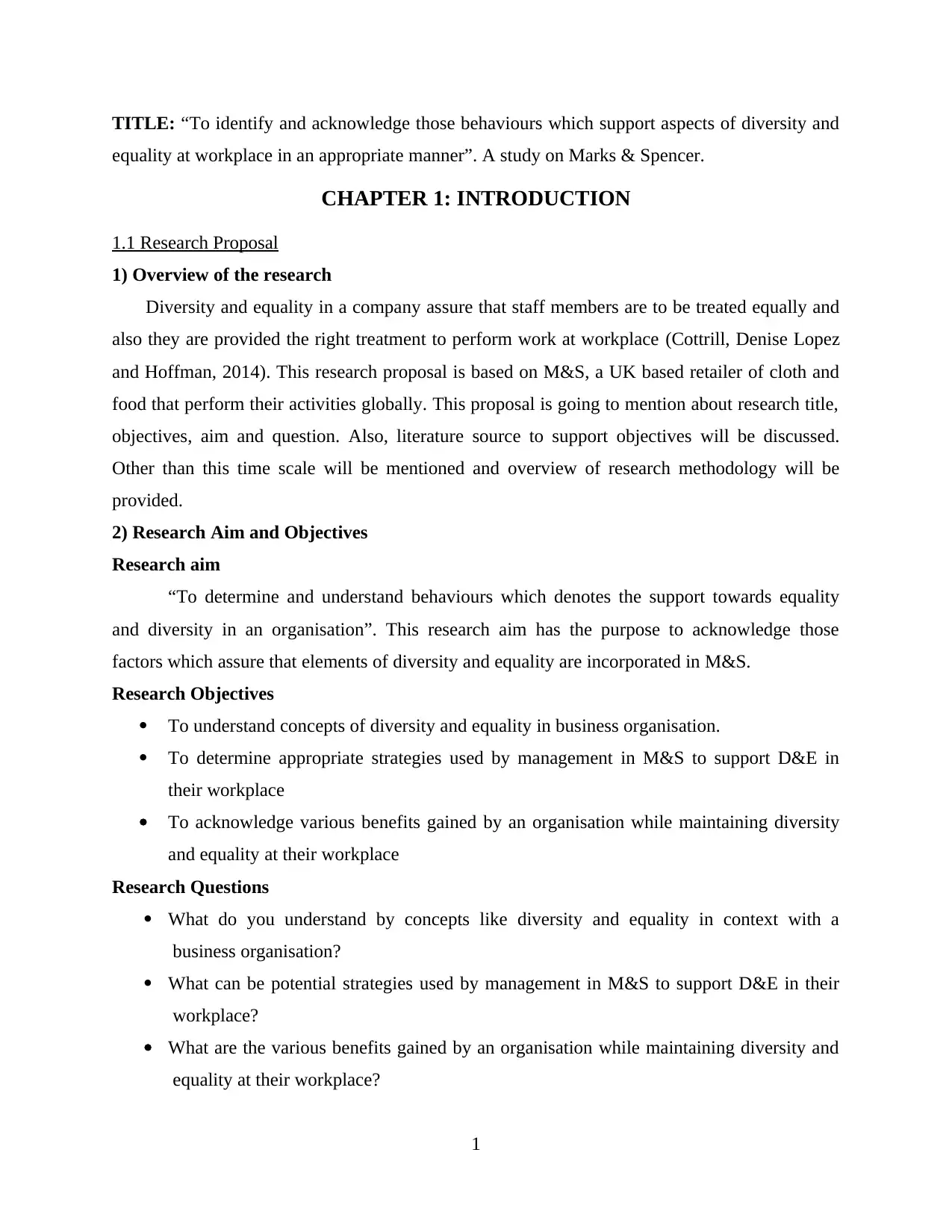
TITLE: “To identify and acknowledge those behaviours which support aspects of diversity and
equality at workplace in an appropriate manner”. A study on Marks & Spencer.
CHAPTER 1: INTRODUCTION
1.1 Research Proposal
1) Overview of the research
Diversity and equality in a company assure that staff members are to be treated equally and
also they are provided the right treatment to perform work at workplace (Cottrill, Denise Lopez
and Hoffman, 2014). This research proposal is based on M&S, a UK based retailer of cloth and
food that perform their activities globally. This proposal is going to mention about research title,
objectives, aim and question. Also, literature source to support objectives will be discussed.
Other than this time scale will be mentioned and overview of research methodology will be
provided.
2) Research Aim and Objectives
Research aim
“To determine and understand behaviours which denotes the support towards equality
and diversity in an organisation”. This research aim has the purpose to acknowledge those
factors which assure that elements of diversity and equality are incorporated in M&S.
Research Objectives
To understand concepts of diversity and equality in business organisation.
To determine appropriate strategies used by management in M&S to support D&E in
their workplace
To acknowledge various benefits gained by an organisation while maintaining diversity
and equality at their workplace
Research Questions
What do you understand by concepts like diversity and equality in context with a
business organisation?
What can be potential strategies used by management in M&S to support D&E in their
workplace?
What are the various benefits gained by an organisation while maintaining diversity and
equality at their workplace?
1
equality at workplace in an appropriate manner”. A study on Marks & Spencer.
CHAPTER 1: INTRODUCTION
1.1 Research Proposal
1) Overview of the research
Diversity and equality in a company assure that staff members are to be treated equally and
also they are provided the right treatment to perform work at workplace (Cottrill, Denise Lopez
and Hoffman, 2014). This research proposal is based on M&S, a UK based retailer of cloth and
food that perform their activities globally. This proposal is going to mention about research title,
objectives, aim and question. Also, literature source to support objectives will be discussed.
Other than this time scale will be mentioned and overview of research methodology will be
provided.
2) Research Aim and Objectives
Research aim
“To determine and understand behaviours which denotes the support towards equality
and diversity in an organisation”. This research aim has the purpose to acknowledge those
factors which assure that elements of diversity and equality are incorporated in M&S.
Research Objectives
To understand concepts of diversity and equality in business organisation.
To determine appropriate strategies used by management in M&S to support D&E in
their workplace
To acknowledge various benefits gained by an organisation while maintaining diversity
and equality at their workplace
Research Questions
What do you understand by concepts like diversity and equality in context with a
business organisation?
What can be potential strategies used by management in M&S to support D&E in their
workplace?
What are the various benefits gained by an organisation while maintaining diversity and
equality at their workplace?
1
Paraphrase This Document
Need a fresh take? Get an instant paraphrase of this document with our AI Paraphraser
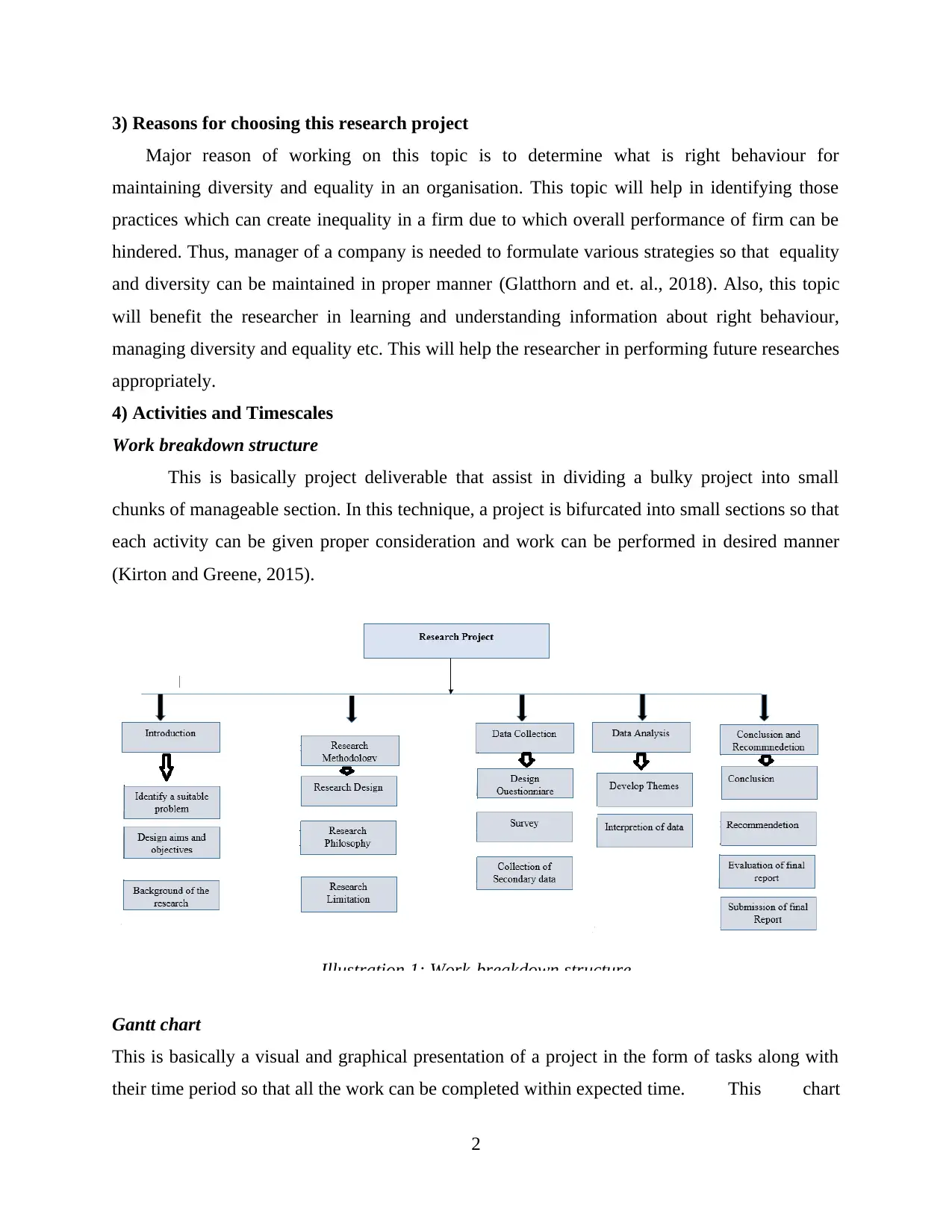
3) Reasons for choosing this research project
Major reason of working on this topic is to determine what is right behaviour for
maintaining diversity and equality in an organisation. This topic will help in identifying those
practices which can create inequality in a firm due to which overall performance of firm can be
hindered. Thus, manager of a company is needed to formulate various strategies so that equality
and diversity can be maintained in proper manner (Glatthorn and et. al., 2018). Also, this topic
will benefit the researcher in learning and understanding information about right behaviour,
managing diversity and equality etc. This will help the researcher in performing future researches
appropriately.
4) Activities and Timescales
Work breakdown structure
This is basically project deliverable that assist in dividing a bulky project into small
chunks of manageable section. In this technique, a project is bifurcated into small sections so that
each activity can be given proper consideration and work can be performed in desired manner
(Kirton and Greene, 2015).
Gantt chart
This is basically a visual and graphical presentation of a project in the form of tasks along with
their time period so that all the work can be completed within expected time. This chart
2
Illustration 1: Work-breakdown structure
Major reason of working on this topic is to determine what is right behaviour for
maintaining diversity and equality in an organisation. This topic will help in identifying those
practices which can create inequality in a firm due to which overall performance of firm can be
hindered. Thus, manager of a company is needed to formulate various strategies so that equality
and diversity can be maintained in proper manner (Glatthorn and et. al., 2018). Also, this topic
will benefit the researcher in learning and understanding information about right behaviour,
managing diversity and equality etc. This will help the researcher in performing future researches
appropriately.
4) Activities and Timescales
Work breakdown structure
This is basically project deliverable that assist in dividing a bulky project into small
chunks of manageable section. In this technique, a project is bifurcated into small sections so that
each activity can be given proper consideration and work can be performed in desired manner
(Kirton and Greene, 2015).
Gantt chart
This is basically a visual and graphical presentation of a project in the form of tasks along with
their time period so that all the work can be completed within expected time. This chart
2
Illustration 1: Work-breakdown structure
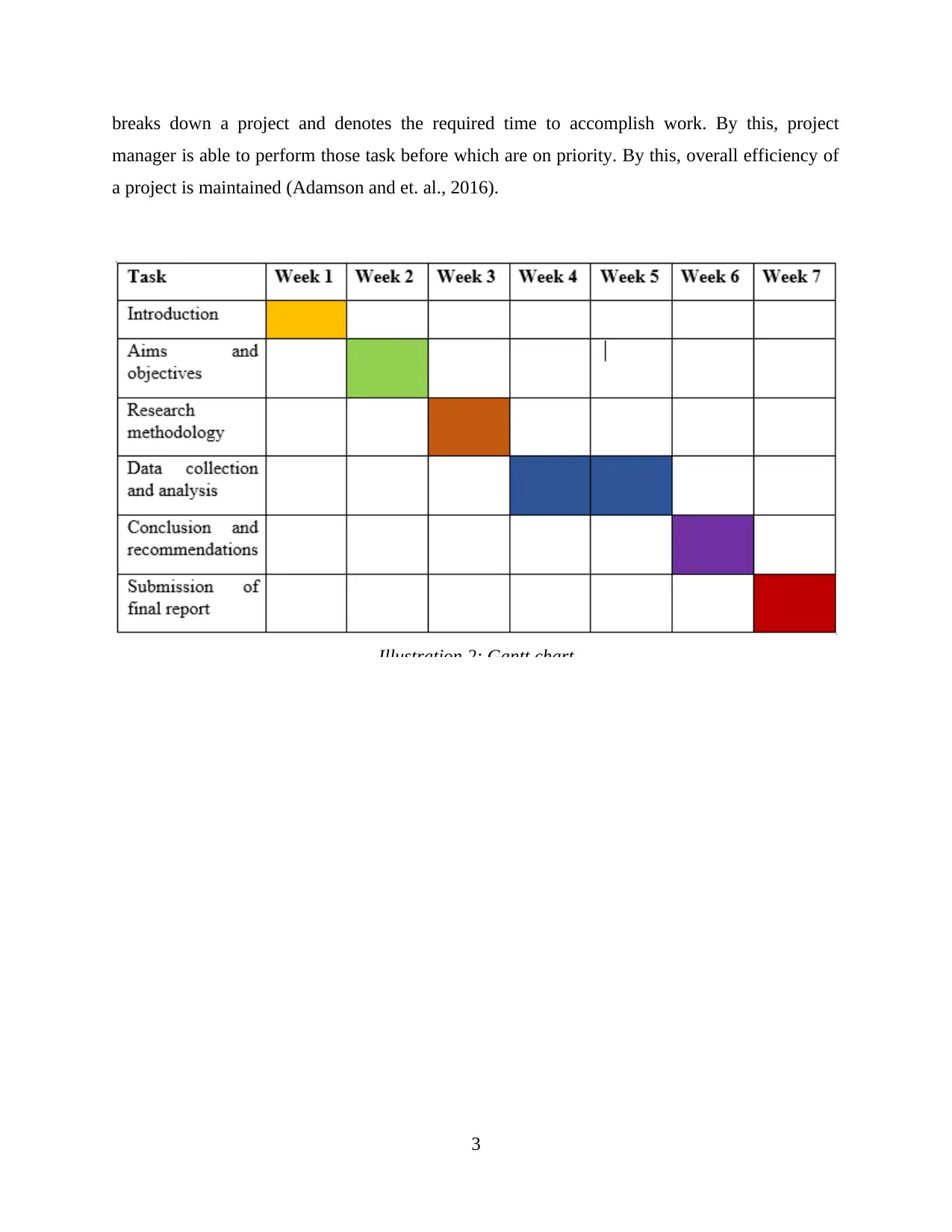
breaks down a project and denotes the required time to accomplish work. By this, project
manager is able to perform those task before which are on priority. By this, overall efficiency of
a project is maintained (Adamson and et. al., 2016).
3
Illustration 2: Gantt chart
manager is able to perform those task before which are on priority. By this, overall efficiency of
a project is maintained (Adamson and et. al., 2016).
3
Illustration 2: Gantt chart
⊘ This is a preview!⊘
Do you want full access?
Subscribe today to unlock all pages.

Trusted by 1+ million students worldwide
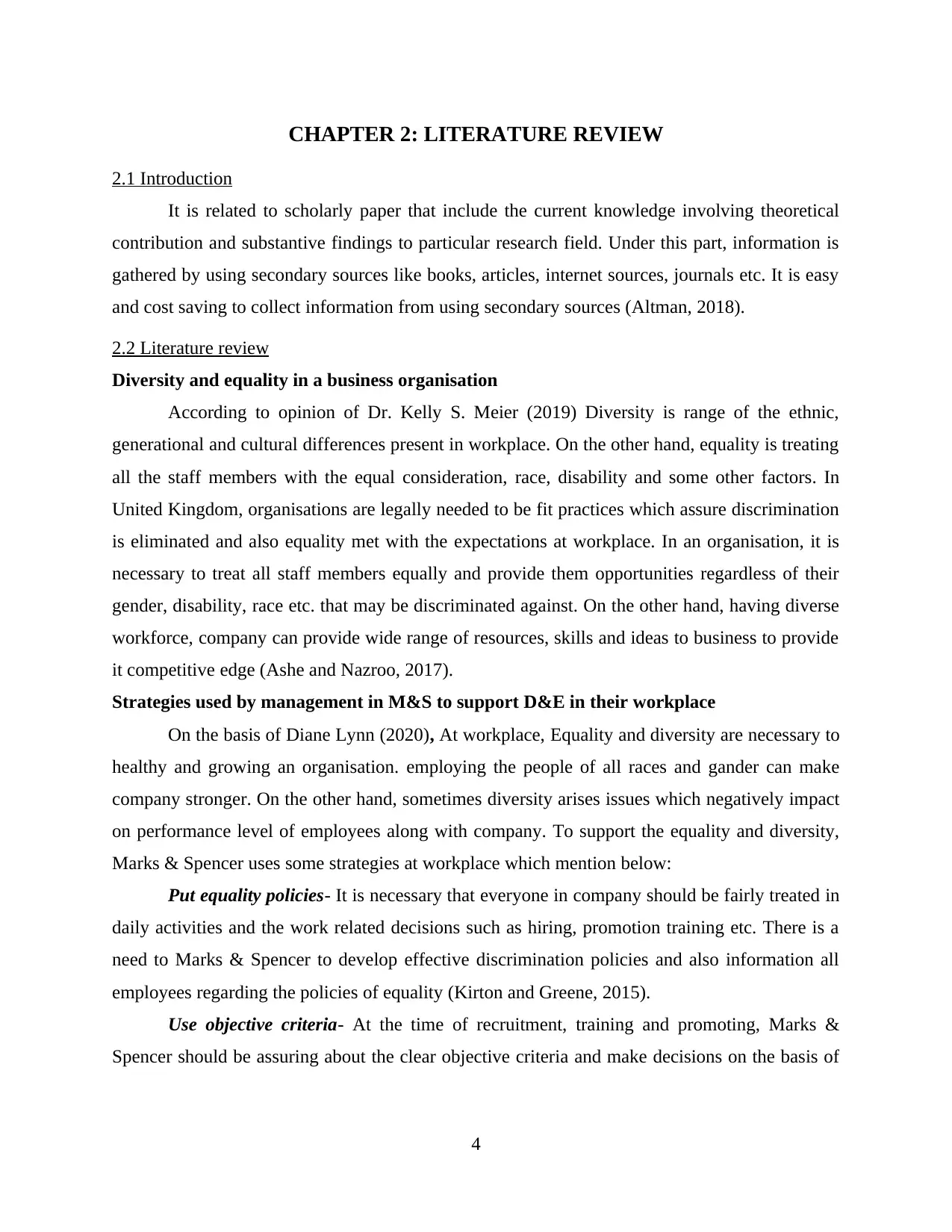
CHAPTER 2: LITERATURE REVIEW
2.1 Introduction
It is related to scholarly paper that include the current knowledge involving theoretical
contribution and substantive findings to particular research field. Under this part, information is
gathered by using secondary sources like books, articles, internet sources, journals etc. It is easy
and cost saving to collect information from using secondary sources (Altman, 2018).
2.2 Literature review
Diversity and equality in a business organisation
According to opinion of Dr. Kelly S. Meier (2019) Diversity is range of the ethnic,
generational and cultural differences present in workplace. On the other hand, equality is treating
all the staff members with the equal consideration, race, disability and some other factors. In
United Kingdom, organisations are legally needed to be fit practices which assure discrimination
is eliminated and also equality met with the expectations at workplace. In an organisation, it is
necessary to treat all staff members equally and provide them opportunities regardless of their
gender, disability, race etc. that may be discriminated against. On the other hand, having diverse
workforce, company can provide wide range of resources, skills and ideas to business to provide
it competitive edge (Ashe and Nazroo, 2017).
Strategies used by management in M&S to support D&E in their workplace
On the basis of Diane Lynn (2020), At workplace, Equality and diversity are necessary to
healthy and growing an organisation. employing the people of all races and gander can make
company stronger. On the other hand, sometimes diversity arises issues which negatively impact
on performance level of employees along with company. To support the equality and diversity,
Marks & Spencer uses some strategies at workplace which mention below:
Put equality policies- It is necessary that everyone in company should be fairly treated in
daily activities and the work related decisions such as hiring, promotion training etc. There is a
need to Marks & Spencer to develop effective discrimination policies and also information all
employees regarding the policies of equality (Kirton and Greene, 2015).
Use objective criteria- At the time of recruitment, training and promoting, Marks &
Spencer should be assuring about the clear objective criteria and make decisions on the basis of
4
2.1 Introduction
It is related to scholarly paper that include the current knowledge involving theoretical
contribution and substantive findings to particular research field. Under this part, information is
gathered by using secondary sources like books, articles, internet sources, journals etc. It is easy
and cost saving to collect information from using secondary sources (Altman, 2018).
2.2 Literature review
Diversity and equality in a business organisation
According to opinion of Dr. Kelly S. Meier (2019) Diversity is range of the ethnic,
generational and cultural differences present in workplace. On the other hand, equality is treating
all the staff members with the equal consideration, race, disability and some other factors. In
United Kingdom, organisations are legally needed to be fit practices which assure discrimination
is eliminated and also equality met with the expectations at workplace. In an organisation, it is
necessary to treat all staff members equally and provide them opportunities regardless of their
gender, disability, race etc. that may be discriminated against. On the other hand, having diverse
workforce, company can provide wide range of resources, skills and ideas to business to provide
it competitive edge (Ashe and Nazroo, 2017).
Strategies used by management in M&S to support D&E in their workplace
On the basis of Diane Lynn (2020), At workplace, Equality and diversity are necessary to
healthy and growing an organisation. employing the people of all races and gander can make
company stronger. On the other hand, sometimes diversity arises issues which negatively impact
on performance level of employees along with company. To support the equality and diversity,
Marks & Spencer uses some strategies at workplace which mention below:
Put equality policies- It is necessary that everyone in company should be fairly treated in
daily activities and the work related decisions such as hiring, promotion training etc. There is a
need to Marks & Spencer to develop effective discrimination policies and also information all
employees regarding the policies of equality (Kirton and Greene, 2015).
Use objective criteria- At the time of recruitment, training and promoting, Marks &
Spencer should be assuring about the clear objective criteria and make decisions on the basis of
4
Paraphrase This Document
Need a fresh take? Get an instant paraphrase of this document with our AI Paraphraser
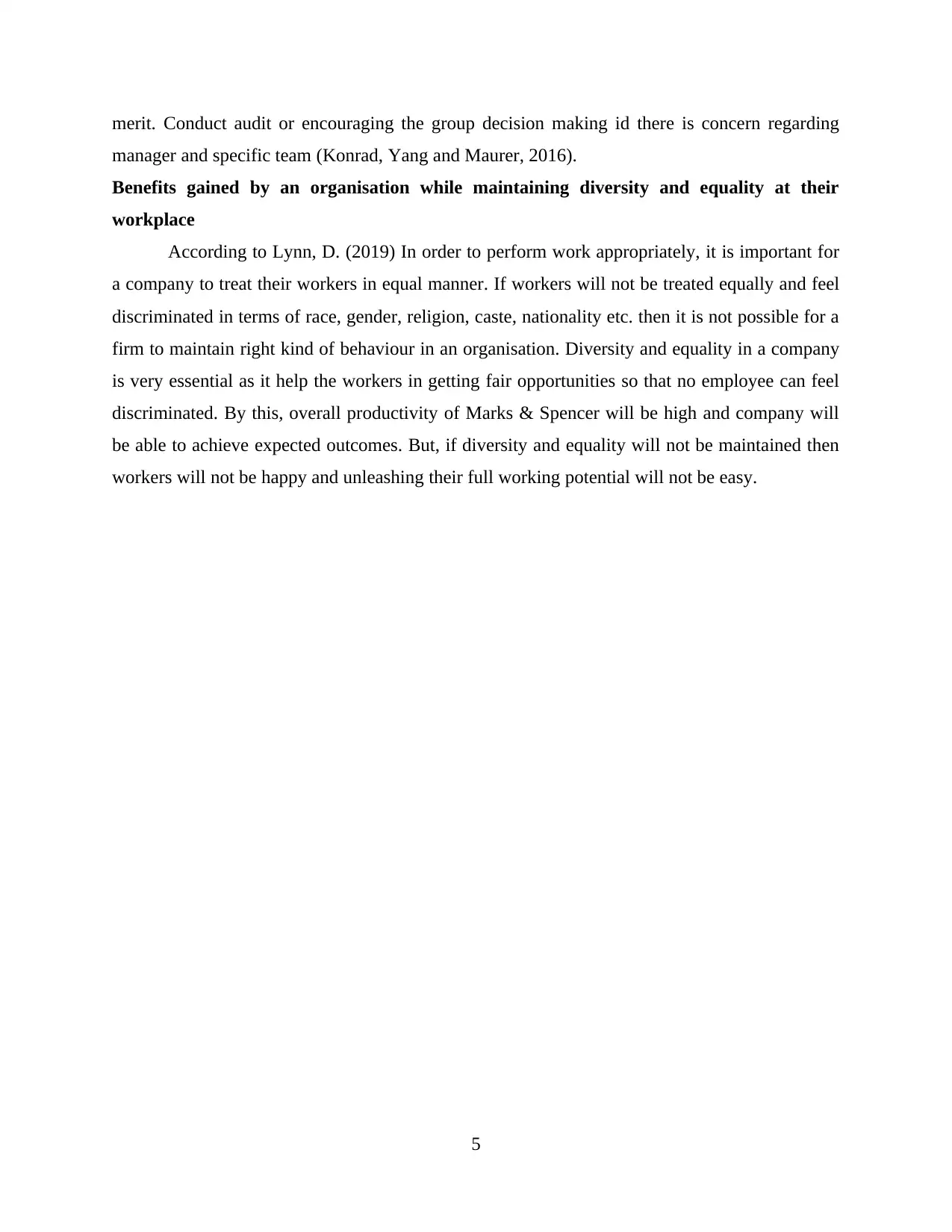
merit. Conduct audit or encouraging the group decision making id there is concern regarding
manager and specific team (Konrad, Yang and Maurer, 2016).
Benefits gained by an organisation while maintaining diversity and equality at their
workplace
According to Lynn, D. (2019) In order to perform work appropriately, it is important for
a company to treat their workers in equal manner. If workers will not be treated equally and feel
discriminated in terms of race, gender, religion, caste, nationality etc. then it is not possible for a
firm to maintain right kind of behaviour in an organisation. Diversity and equality in a company
is very essential as it help the workers in getting fair opportunities so that no employee can feel
discriminated. By this, overall productivity of Marks & Spencer will be high and company will
be able to achieve expected outcomes. But, if diversity and equality will not be maintained then
workers will not be happy and unleashing their full working potential will not be easy.
5
manager and specific team (Konrad, Yang and Maurer, 2016).
Benefits gained by an organisation while maintaining diversity and equality at their
workplace
According to Lynn, D. (2019) In order to perform work appropriately, it is important for
a company to treat their workers in equal manner. If workers will not be treated equally and feel
discriminated in terms of race, gender, religion, caste, nationality etc. then it is not possible for a
firm to maintain right kind of behaviour in an organisation. Diversity and equality in a company
is very essential as it help the workers in getting fair opportunities so that no employee can feel
discriminated. By this, overall productivity of Marks & Spencer will be high and company will
be able to achieve expected outcomes. But, if diversity and equality will not be maintained then
workers will not be happy and unleashing their full working potential will not be easy.
5
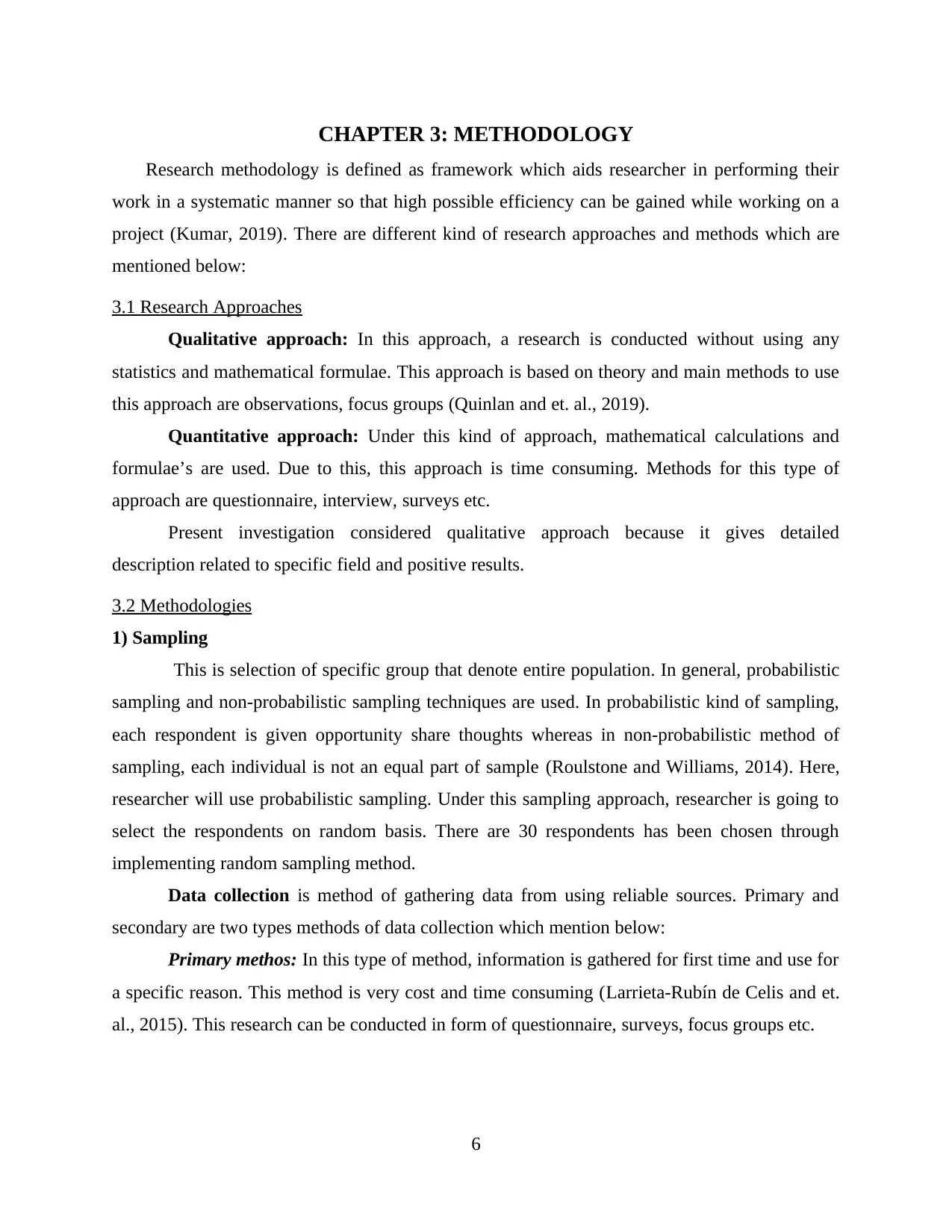
CHAPTER 3: METHODOLOGY
Research methodology is defined as framework which aids researcher in performing their
work in a systematic manner so that high possible efficiency can be gained while working on a
project (Kumar, 2019). There are different kind of research approaches and methods which are
mentioned below:
3.1 Research Approaches
Qualitative approach: In this approach, a research is conducted without using any
statistics and mathematical formulae. This approach is based on theory and main methods to use
this approach are observations, focus groups (Quinlan and et. al., 2019).
Quantitative approach: Under this kind of approach, mathematical calculations and
formulae’s are used. Due to this, this approach is time consuming. Methods for this type of
approach are questionnaire, interview, surveys etc.
Present investigation considered qualitative approach because it gives detailed
description related to specific field and positive results.
3.2 Methodologies
1) Sampling
This is selection of specific group that denote entire population. In general, probabilistic
sampling and non-probabilistic sampling techniques are used. In probabilistic kind of sampling,
each respondent is given opportunity share thoughts whereas in non-probabilistic method of
sampling, each individual is not an equal part of sample (Roulstone and Williams, 2014). Here,
researcher will use probabilistic sampling. Under this sampling approach, researcher is going to
select the respondents on random basis. There are 30 respondents has been chosen through
implementing random sampling method.
Data collection is method of gathering data from using reliable sources. Primary and
secondary are two types methods of data collection which mention below:
Primary methos: In this type of method, information is gathered for first time and use for
a specific reason. This method is very cost and time consuming (Larrieta‐Rubín de Celis and et.
al., 2015). This research can be conducted in form of questionnaire, surveys, focus groups etc.
6
Research methodology is defined as framework which aids researcher in performing their
work in a systematic manner so that high possible efficiency can be gained while working on a
project (Kumar, 2019). There are different kind of research approaches and methods which are
mentioned below:
3.1 Research Approaches
Qualitative approach: In this approach, a research is conducted without using any
statistics and mathematical formulae. This approach is based on theory and main methods to use
this approach are observations, focus groups (Quinlan and et. al., 2019).
Quantitative approach: Under this kind of approach, mathematical calculations and
formulae’s are used. Due to this, this approach is time consuming. Methods for this type of
approach are questionnaire, interview, surveys etc.
Present investigation considered qualitative approach because it gives detailed
description related to specific field and positive results.
3.2 Methodologies
1) Sampling
This is selection of specific group that denote entire population. In general, probabilistic
sampling and non-probabilistic sampling techniques are used. In probabilistic kind of sampling,
each respondent is given opportunity share thoughts whereas in non-probabilistic method of
sampling, each individual is not an equal part of sample (Roulstone and Williams, 2014). Here,
researcher will use probabilistic sampling. Under this sampling approach, researcher is going to
select the respondents on random basis. There are 30 respondents has been chosen through
implementing random sampling method.
Data collection is method of gathering data from using reliable sources. Primary and
secondary are two types methods of data collection which mention below:
Primary methos: In this type of method, information is gathered for first time and use for
a specific reason. This method is very cost and time consuming (Larrieta‐Rubín de Celis and et.
al., 2015). This research can be conducted in form of questionnaire, surveys, focus groups etc.
6
⊘ This is a preview!⊘
Do you want full access?
Subscribe today to unlock all pages.

Trusted by 1+ million students worldwide
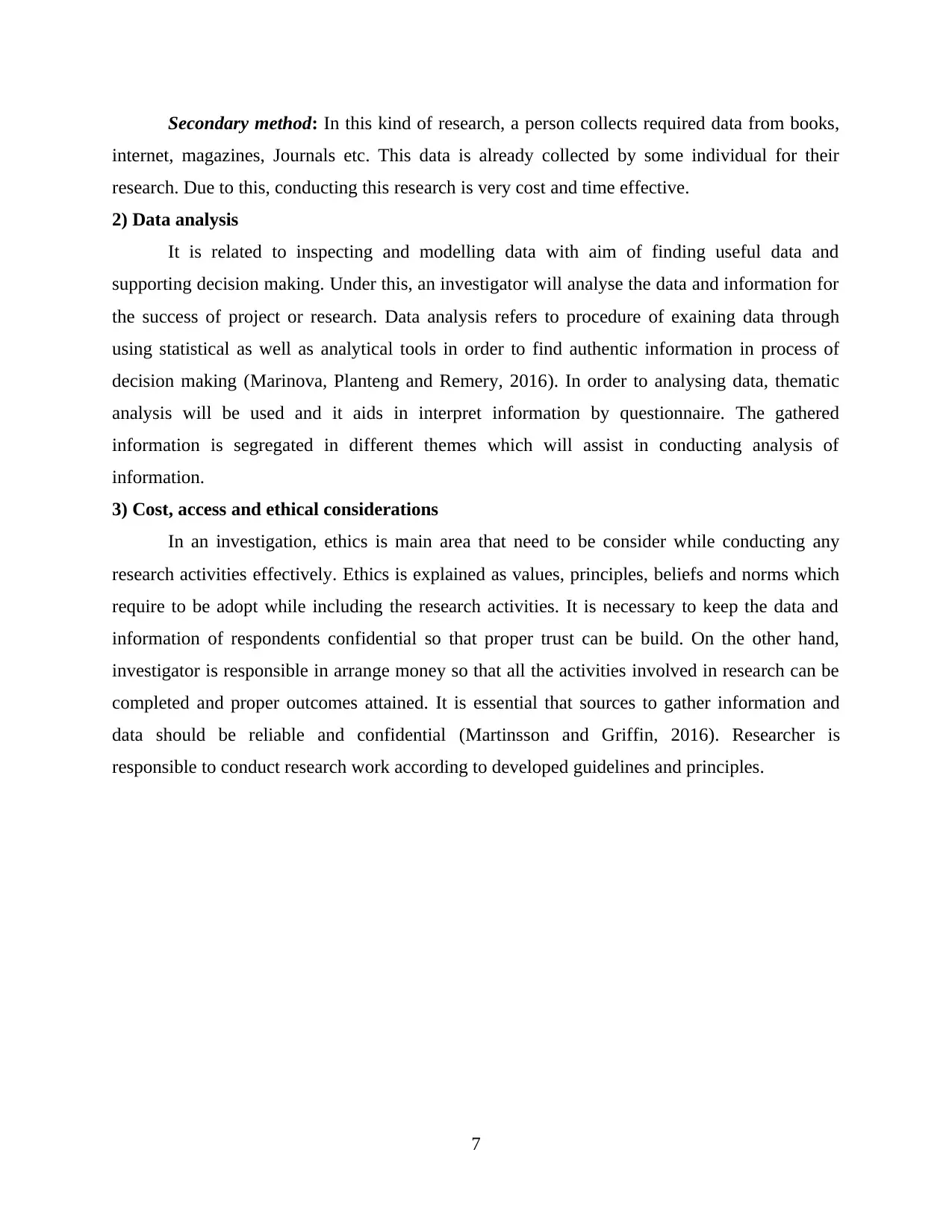
Secondary method: In this kind of research, a person collects required data from books,
internet, magazines, Journals etc. This data is already collected by some individual for their
research. Due to this, conducting this research is very cost and time effective.
2) Data analysis
It is related to inspecting and modelling data with aim of finding useful data and
supporting decision making. Under this, an investigator will analyse the data and information for
the success of project or research. Data analysis refers to procedure of exaining data through
using statistical as well as analytical tools in order to find authentic information in process of
decision making (Marinova, Planteng and Remery, 2016). In order to analysing data, thematic
analysis will be used and it aids in interpret information by questionnaire. The gathered
information is segregated in different themes which will assist in conducting analysis of
information.
3) Cost, access and ethical considerations
In an investigation, ethics is main area that need to be consider while conducting any
research activities effectively. Ethics is explained as values, principles, beliefs and norms which
require to be adopt while including the research activities. It is necessary to keep the data and
information of respondents confidential so that proper trust can be build. On the other hand,
investigator is responsible in arrange money so that all the activities involved in research can be
completed and proper outcomes attained. It is essential that sources to gather information and
data should be reliable and confidential (Martinsson and Griffin, 2016). Researcher is
responsible to conduct research work according to developed guidelines and principles.
7
internet, magazines, Journals etc. This data is already collected by some individual for their
research. Due to this, conducting this research is very cost and time effective.
2) Data analysis
It is related to inspecting and modelling data with aim of finding useful data and
supporting decision making. Under this, an investigator will analyse the data and information for
the success of project or research. Data analysis refers to procedure of exaining data through
using statistical as well as analytical tools in order to find authentic information in process of
decision making (Marinova, Planteng and Remery, 2016). In order to analysing data, thematic
analysis will be used and it aids in interpret information by questionnaire. The gathered
information is segregated in different themes which will assist in conducting analysis of
information.
3) Cost, access and ethical considerations
In an investigation, ethics is main area that need to be consider while conducting any
research activities effectively. Ethics is explained as values, principles, beliefs and norms which
require to be adopt while including the research activities. It is necessary to keep the data and
information of respondents confidential so that proper trust can be build. On the other hand,
investigator is responsible in arrange money so that all the activities involved in research can be
completed and proper outcomes attained. It is essential that sources to gather information and
data should be reliable and confidential (Martinsson and Griffin, 2016). Researcher is
responsible to conduct research work according to developed guidelines and principles.
7
Paraphrase This Document
Need a fresh take? Get an instant paraphrase of this document with our AI Paraphraser
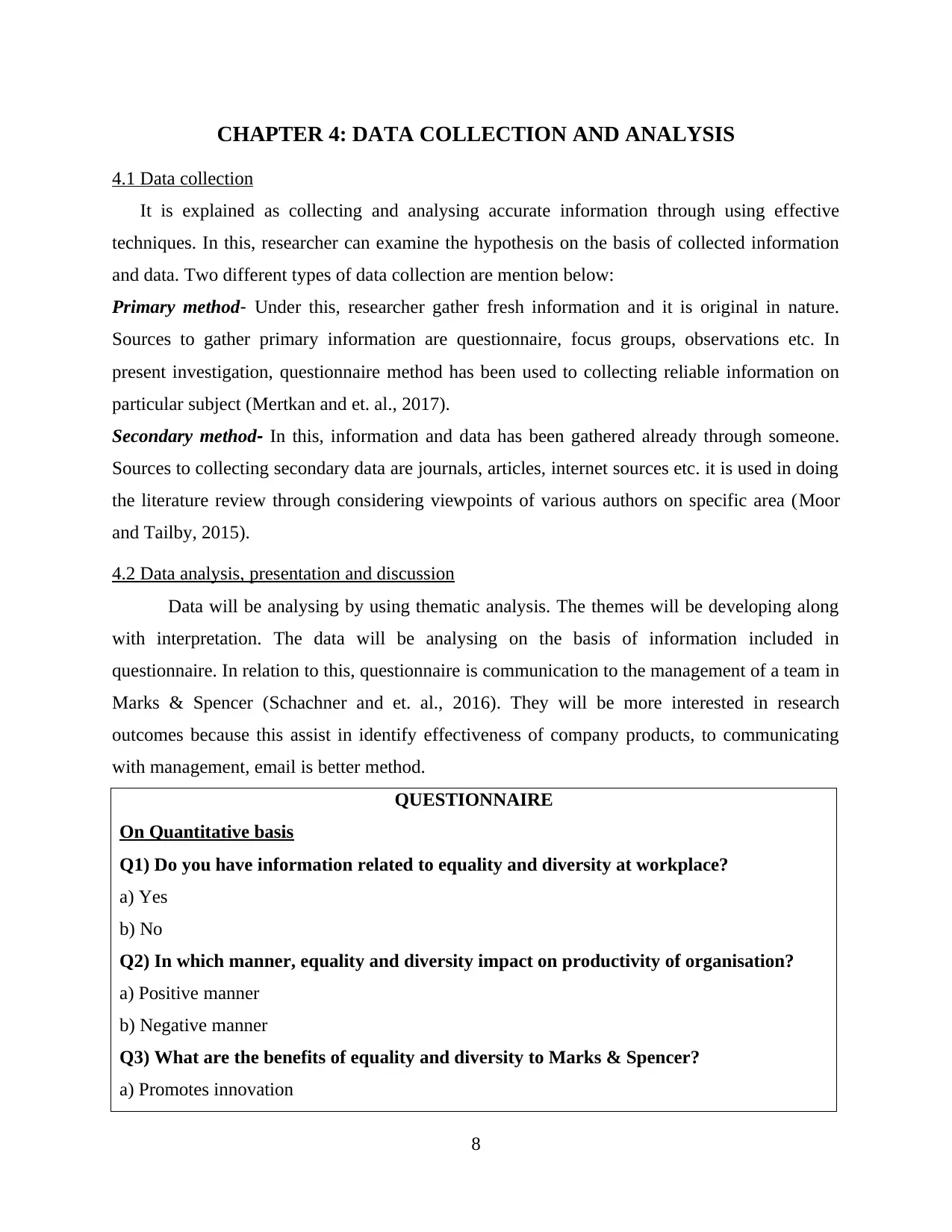
CHAPTER 4: DATA COLLECTION AND ANALYSIS
4.1 Data collection
It is explained as collecting and analysing accurate information through using effective
techniques. In this, researcher can examine the hypothesis on the basis of collected information
and data. Two different types of data collection are mention below:
Primary method- Under this, researcher gather fresh information and it is original in nature.
Sources to gather primary information are questionnaire, focus groups, observations etc. In
present investigation, questionnaire method has been used to collecting reliable information on
particular subject (Mertkan and et. al., 2017).
Secondary method- In this, information and data has been gathered already through someone.
Sources to collecting secondary data are journals, articles, internet sources etc. it is used in doing
the literature review through considering viewpoints of various authors on specific area (Moor
and Tailby, 2015).
4.2 Data analysis, presentation and discussion
Data will be analysing by using thematic analysis. The themes will be developing along
with interpretation. The data will be analysing on the basis of information included in
questionnaire. In relation to this, questionnaire is communication to the management of a team in
Marks & Spencer (Schachner and et. al., 2016). They will be more interested in research
outcomes because this assist in identify effectiveness of company products, to communicating
with management, email is better method.
QUESTIONNAIRE
On Quantitative basis
Q1) Do you have information related to equality and diversity at workplace?
a) Yes
b) No
Q2) In which manner, equality and diversity impact on productivity of organisation?
a) Positive manner
b) Negative manner
Q3) What are the benefits of equality and diversity to Marks & Spencer?
a) Promotes innovation
8
4.1 Data collection
It is explained as collecting and analysing accurate information through using effective
techniques. In this, researcher can examine the hypothesis on the basis of collected information
and data. Two different types of data collection are mention below:
Primary method- Under this, researcher gather fresh information and it is original in nature.
Sources to gather primary information are questionnaire, focus groups, observations etc. In
present investigation, questionnaire method has been used to collecting reliable information on
particular subject (Mertkan and et. al., 2017).
Secondary method- In this, information and data has been gathered already through someone.
Sources to collecting secondary data are journals, articles, internet sources etc. it is used in doing
the literature review through considering viewpoints of various authors on specific area (Moor
and Tailby, 2015).
4.2 Data analysis, presentation and discussion
Data will be analysing by using thematic analysis. The themes will be developing along
with interpretation. The data will be analysing on the basis of information included in
questionnaire. In relation to this, questionnaire is communication to the management of a team in
Marks & Spencer (Schachner and et. al., 2016). They will be more interested in research
outcomes because this assist in identify effectiveness of company products, to communicating
with management, email is better method.
QUESTIONNAIRE
On Quantitative basis
Q1) Do you have information related to equality and diversity at workplace?
a) Yes
b) No
Q2) In which manner, equality and diversity impact on productivity of organisation?
a) Positive manner
b) Negative manner
Q3) What are the benefits of equality and diversity to Marks & Spencer?
a) Promotes innovation
8
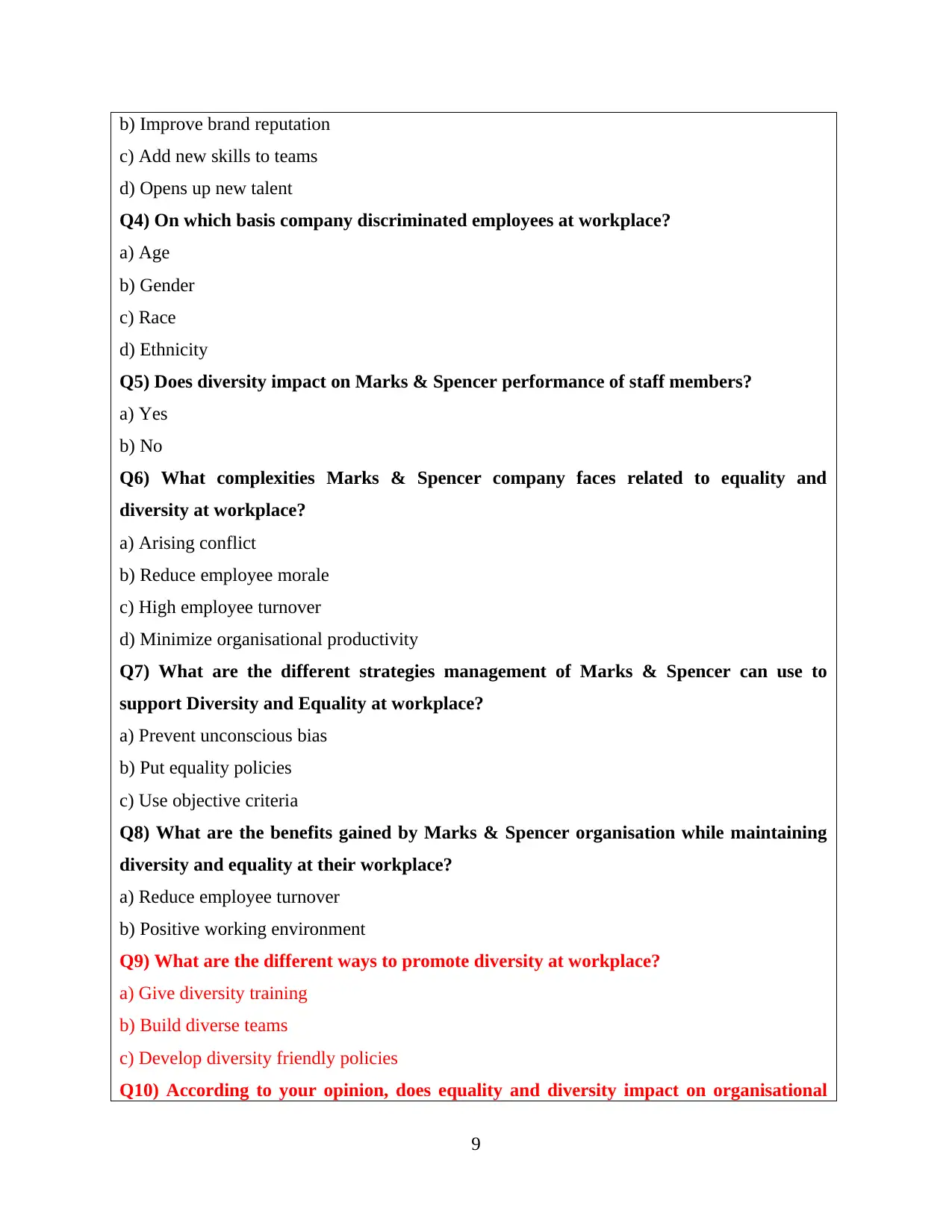
b) Improve brand reputation
c) Add new skills to teams
d) Opens up new talent
Q4) On which basis company discriminated employees at workplace?
a) Age
b) Gender
c) Race
d) Ethnicity
Q5) Does diversity impact on Marks & Spencer performance of staff members?
a) Yes
b) No
Q6) What complexities Marks & Spencer company faces related to equality and
diversity at workplace?
a) Arising conflict
b) Reduce employee morale
c) High employee turnover
d) Minimize organisational productivity
Q7) What are the different strategies management of Marks & Spencer can use to
support Diversity and Equality at workplace?
a) Prevent unconscious bias
b) Put equality policies
c) Use objective criteria
Q8) What are the benefits gained by Marks & Spencer organisation while maintaining
diversity and equality at their workplace?
a) Reduce employee turnover
b) Positive working environment
Q9) What are the different ways to promote diversity at workplace?
a) Give diversity training
b) Build diverse teams
c) Develop diversity friendly policies
Q10) According to your opinion, does equality and diversity impact on organisational
9
c) Add new skills to teams
d) Opens up new talent
Q4) On which basis company discriminated employees at workplace?
a) Age
b) Gender
c) Race
d) Ethnicity
Q5) Does diversity impact on Marks & Spencer performance of staff members?
a) Yes
b) No
Q6) What complexities Marks & Spencer company faces related to equality and
diversity at workplace?
a) Arising conflict
b) Reduce employee morale
c) High employee turnover
d) Minimize organisational productivity
Q7) What are the different strategies management of Marks & Spencer can use to
support Diversity and Equality at workplace?
a) Prevent unconscious bias
b) Put equality policies
c) Use objective criteria
Q8) What are the benefits gained by Marks & Spencer organisation while maintaining
diversity and equality at their workplace?
a) Reduce employee turnover
b) Positive working environment
Q9) What are the different ways to promote diversity at workplace?
a) Give diversity training
b) Build diverse teams
c) Develop diversity friendly policies
Q10) According to your opinion, does equality and diversity impact on organisational
9
⊘ This is a preview!⊘
Do you want full access?
Subscribe today to unlock all pages.

Trusted by 1+ million students worldwide
1 out of 38
Related Documents
Your All-in-One AI-Powered Toolkit for Academic Success.
+13062052269
info@desklib.com
Available 24*7 on WhatsApp / Email
![[object Object]](/_next/static/media/star-bottom.7253800d.svg)
Unlock your academic potential
Copyright © 2020–2025 A2Z Services. All Rights Reserved. Developed and managed by ZUCOL.




